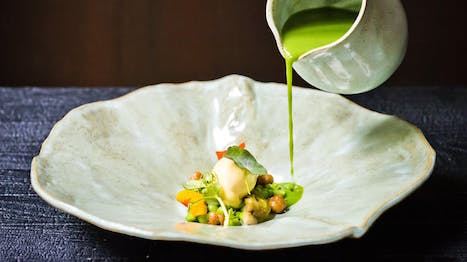When it comes to culinary experiences, retail, hospitality and dining will increasingly overlap, as global spending on foodservice continues to rise.
According to JLL’s 2019 Foodservice Trend report, nearly three-quarters of foodservice spend in 2018 was on dining-in occasions. As consumers seek out more unique experiences, luxury brands across the retail and hospitality sectors are ramping up their culinary offerings.
Dining out
As bricks-and-mortar retailers look to draw in more shoppers, restaurants and food offerings can be key.
Forty percent of consumers select their favorite retail destinations based on available dining options.

Chef Joshua Overington creates special dishes for blind tasting. Image credit: Harvey Nichols
Shoppers who enjoy foodservice at retail centers spend up to 35 percent more time there. They also spend an average 15 percent more on purchases.
By 2025, food and beverage retailers are expected to take up to 20 percent of space within retail centers.
Neiman Marcus’ first location in New York has multiple dining spaces at the Shops and Restaurants at Hudson Yards.
The Zodiac Room, Neiman Marcus’ fine dining restaurant, is on level seven. Found a floor below is Bar Stanley, which serves the favorite meals of the retailer’s late chairman, Stanley Marcus (see story).
Similarly, as department store chain Saks Fifth Avenue entered the Canadian retail landscape, it focused on food services in addition to its style and beauty offerings.
Its Toronto locations include a Saks Food Hall by Pusateri’s Fine Food where international foods are served and prepared. A fine dining option put forth by Oliver & Bonacini, one of Canada’s leading restaurant, events and catering companies, offers a unique culinary concept for each store (see story).
Retailers are also adding more culinary experiences for limited times.
British department store chain Harvey Nichols leaned into experiential offerings with a special event tapping into the blind tasting trend. In partnership with French restaurant Le Cochon Aveugle, the department store created a special menu for diners who did not know what they were eating ahead of time (see story).
Hospitality groups are also investing more in dining. With services such as Airbnb disrupting the travel industry, culinary experiences are another way for hotels to differentiate themselves.
After lodging, travelers spent $48.7 billion within hotels in 2017. This figure includes spending at hotel restaurants, bars, lounges and room service.
Since culinary exploration is more popular than ever among affluent travelers, many hoteliers are capitalizing on holidays as chance to experiment with various cuisines.
For the Lunar New Year, The Ritz-Carlton, San Francisco reimagined its afternoon tea service and incorporated Chinese dim sum, including dumplings and fortune cookies. Guests could also attend a self-guided tour organized by the hotel's executive chef that explored the city’s legendary Chinatown (see story).

Ritz-Carlton guests can enjoy heart-shaped desserts. Image credit: Ritz-Carlton
Hospitality group Omni Hotels & Resorts is crafting culinary experiences for a younger traveler. Through its Culinary Kids program, the hotel group is leaning into the Instagrammable food trend with even younger consumers, crafting a special kids menu that allows those aged 12 and younger to opt for more sophisticated dishes (see story).
Food is also playing a role in air travel, as more private jet firms personalize journeys with clients’ favorite food or cuisine reflective of a destination. For instance, private aviation firm VistaJet helped flyers celebrate Valentine’s Day by stocking cabins with roses, personalized hand-crafted chocolates and a bottle of distinguished Dom Pérignon P2 (see story).
Sustainable food
Consumers are also incorporating healthier, more sustainable food into their diets.
Seventy-four percent of millennials in the U.S. and U.K. are willing to change their diets to reduce their impact on the planet, according to JLL.
Companies are also getting involved.
Hospitality group Relais & Châteaux participated in the international Menu For Change program in an effort to highlight how high-end restaurants can fight global warming.
Chefs at Relais & Châteaux restaurants aimed to serve “good, clean and fair food” in support of the Slow Food association. Part of the program’s intention is to show how everyday adjustments, like making “clean" meals, can combat climate change (see story).
Hospitality group Four Seasons Hotels’ George V. Paris location similarly continued its streak of culinary innovation by opening the doors to its sustainable garden.
The property, known for being the first hotel to earn five Michelin stars from three of its restaurants, hosts a special garden on its property rooted in history. Four Seasons George V. Paris recently established a partnership with Les Alchimistes, a start-up in France that collects organic waste and processes it into compost “made in Paris” (see story)
{"ct":"JaijiaA\/S91BvyxpgyhQNeJb0+dvQo9ah2DZqDUI+gSRfgLnJHaRj2YOHntzAwkMEWBBD\/PnWCZi5veX4CYP6IMyWOOZtrMMfaQ4gXEGxDpsQZTeXMEzxHfLaoMAkDasSpNggZK6yZFS1+tl+VJWJYnFz77VjmSNhgworJ6B1gIzkiaHbMOF+KWfbwx+QeiWbhhLyXNtFCww6cYnqzLKdXeXA\/\/nwyq9rrcZJmQkqtxTXlGNiF3X1AdaBWohI06nlg9R0eAl6nAxVFh9cvx70e\/04ZszZKcQvAVuuYJyZyTSY1F2i6QmVQBQp\/ZoSLxoivXnSyVj5oXHX1hYOisGyhiewFaSYuMa0BTjpJoZv6XxXhNpxJGKEIEkMgMlFUMQnE9MTBWYRkghcK2trXDLpPXG9XYVeVvAZly06ZKpWoXThMZzPJxKg2YMbLUsW7f3DClfM0Zovq9fsYVG2xvl8MOhyVEo89lNHGBvnVf1DVbjIlLjZbV+kvh\/GJdfDmV3b1hmqJVuhnckSY\/CX+kt5ukBHGFtGnPC\/PVj6nJQ0ycMoJBK7n7eM2Jm5MTnE4YNavPOJmLv7pDBNZd8172LXdnrrLUXaPsn6srGCSMQh+YOFZ7rRF\/nLxtECQA72YTRO0eZmZZHOv+rm4MhaKi2QDFlTOy22R\/M2SrXriFKcaElufOXH8pJvEvrnVwkH04GXyW2XH\/RtwLiUAvBCwEWHiTG2JjJpjW8NpTCwrju0pDVgPmfkR3Xvx84YB2S1hczH6TzFDiZ1bT21Amp2gEEuSRw4y6S0VuQ1KyZu0uy8\/iBxhRMT58rdXqA9Q4IzgE3v2rHPhHSj0H9MIcuXL7kO5dAeaZA1slaQW6PeG5o+YcN66Y8v1Yu6DoxjJa2RmlvzzNITQMa0PUCUTkzIEh5pMQI00LYeGhqP51mgO7CRpFVMBPbGRhrjW+AJPKpd\/q+srofzJeJJDA2+Bgu3nBnmZHzhpDWdg86zPCsr3ckptg0iqmPRrRVJOVsUEiDAPXMxDVxQCNdOWkYQKDg7CZmMUphKlbQMgmXT0tFycWUawiBFRAz31F01ihh796zVVOiEZFOkDQ5CBMXxsnZKRB0Rx4pmOkxj6krhp4888zSEDWIglvD+v030gjXGcspqxCNxGkfzsIopzqMV\/zKv\/aKJ8uN+OPsX7M6UCB5chQwF6f6Q0xAOx9Wox6QD7lvWBHrljzPtTB9ep1fYvy09e34P6jHVcgVnms+YnMNsF0c+wDZuS\/e3T8GG3ooYox8qhEB7ugONFwcIladYX4rfdCrXQR0aI9bzJlzaSrOEMculFWZDAPO9flvO2LATbCVSiNFMv7nioBrd7wg5fKfZzQrfuPWjA59\/0bhYzpR0kn03nDI1MTN5GRaEBLuj9eVB2oD+JhEu9NGPip1RJ9fZNJlu\/ZfYRmmtKCe7J9BrAjwuNKbE3LsJfbQkz6Lfeo8A0DDlW2DU27PuKR7Kg0n5cIDjZyG7PNtT8Kq+MNwDgpH9J2Gtc2PqGyTuXleNUxhGbJhr3QXwAf4QZIiZ1nvFBZTpzXBe4J1DdQYb7hXzc74IF1RjfuPKoXzlYM0Jpxw8rDMDF0wAmazwa7tomtHGiQUwyrv1+fRp4qP\/pgnKTbtrKoKm7Xpy4t4YHHzvgWTls7os30XPE6hOswfObbow+lxYy3YoicS8S0k6RIQSz7kAlFTHHVN+FATMdVENaUKj3nC2+VRpDSUwnAE7dArE60k3874EWSMvqaeKLI82Wo6gfoGQ+dMtlQH27abJaGvISF6kH0TVGp0hzMBBAr1TR9dhZB6sHha9frM8QyOUOLlcvpUmBrIWcoZMvkZfi1rHRzO1buV4w7a3UuAt0oGEHJWiGWp4RfeqEZ3LXqrKwVoZImA6lZG\/F9eCNuqO2aF5Prg1dkDfnGMGhE74wp7SACptscg48di\/stmbxiyjY3tcovf+rYt5qgAu9y65A8xtjO1\/bcn0rV8bcAbi4qoTWqn3snY5JFoOlA3lJQqssN\/s973HxzsyOBDngIbkzDtkapZKFAd9x\/MfIyCvqXhUKNbmrsqPKP4t+cB9y4a+j\/7qfmrgmD0dvvNGeYCCIXrs3ECUi268illgSFp9VBev46AUSqOfngOLSM59W4M5wyRao6r8HPxkvqKasuEAEh8bly37ESXpZ5cHd7tdRbx9PwX4UlhFLlFn73BbedmcCs4xWYnEgkhk4S0KoE80iCI5W7d2k8xcOX\/KVWYyhHc5UlgfvlcvgbgL0JAJwkFuU0tg1FSM5GaXJ4vYfsXHhOj3dM7yjEqO3pdgY2zuR8I64rxCMSdxTzqnvnTET\/I6OFSiwcrTJ5fkv1f8vYkkB4lqllR5MahGzG+Kx9tH+UnEynIXJ28l+LXmP+0jpJN6yE4NPQW8kLx1TJLhOiB9cA0jv1ur4hWGLI6ilUpdZRe82QXf5RTe3NUqm6YJfM4w8BqI8PrzvJj3\/4HS+wgfqWOD4xdctCyw2+ylH9r9Iowr0AdpWX6EXEH1D0XYpPRiOMPlvOuaC73UNiE2\/kUo6N4sHgS97ieZTOvR0yo2FmU9sbAohC6bR0ZK4W0sjMjMjd5wdfqAvKsc2gt4NaRXrrP8DVYuJPOG+TT6SIDuEtc4KGCEEpTo9MjkunMGoh19Ch02CpnAdcYTNEcNMFfIzZE6qJW349s1fJ\/D5S6rf0uZOT5TZdH09g5ehQUb6DLWbIiU1aM8JUWYHNtwWSjYq3TN1h2\/Hx6Hq9PtqV7r4DNDNFp7np\/aKx3TjSBsugsItcrJz+Ulo0em\/0l0q72nz6MP1cpzRXQZXjBCQYVHW\/CrwKwZRT2AJuIH\/VK\/EErryRSZQ9xRVY31mWrYb00nVR3slOQOGTdlcih\/NPVCP7K+UiVzDLqLuTTloEf0vSOKSnsY8aImrcgWzqiCuG6HIK9m7tQm4hp5MYrFLeWs\/uD8Ict9q2n3YVCzc49IGTCDfRuMveJEAGF4krm8vkYc55xRJ4fFGCrpHMYp+u1dHrXhuMC+HYR3E+AeRH4GIAG2nJZlX7Mr4GKA67I6hpQX67ogh3F3kM+I3S+sij5M\/2mNLWhmrzMcAvpB6+aVlGAO+FmoUUmVaD3\/3ns0UNka\/JYYR7npCZ2m0Pt9pIM1iJQY1lx1i48XFTk7047bneHMsdk2KqUVkJQXLQl9QikJmH8pdaMIGhCVejb7XmII2pe8VgOsMbfwm4uOZ\/Ui5rElwm7zNQ+2w4tCxTURYRCJG4+5E6gD8biLP9rR\/paifJOSOxggUy46DPxfxnAkPFICmHcHMab+Amv2gBYvws153XVk4zbYSlE67EZMEgmJQVDISWUx\/zBoNR6Eyht3B3+uVnkNoII7f+cHvQrbavwieXKUIM9en1RRW7R3588bD8cdxC8BIywQzwkf\/UusFkuHh7CFIwKjDQalhx0W4WKZmXPR7E1lMj8NLYDj\/sifabW95tu7xU8rYtntJgev6\/Jx5yt8B7ZVmxvmEoGLvDRmmSkZWSNBogt+MvOAWobEM8dD4PW0qbF\/LzznO83sLZrRMrH\/ZdkCxib9wPsPalIRahtmPWN72QJgXAMa+oHUx3o4MoqJehqEOSGaNSw5LmlKUhWf\/G18UwTIXGHubY2AbCljaaBvFDTuVyCH08CJ0ycSC39jPSYgkRGRRTUvtCydktNWm34ToMssOJijKCFH+YvoAorPYBR83H3RXTJeDzwJT1RHtjE+5tvVOxWKlv8IclaaGM+uegTYlFw73zthICO2aektJv3afXP0Xn69Ldr8lFVuu\/dD1HsQf5g593PQmPDw42mAAESPeKItYwnIT0+sWSrdmR0m\/J5VoG3JwseLgtFXgX1RrGDwpGFsJR2DYoyDJA55arS0sYfDzqmrEIgIU8swF8tjwbLpaFP32VoQ1bhkoh8XLCjlzFoSRFipUZcz5P13kjdtqsyDJODHkIj3YAmRtniscHPnd3KJsxEZM57Z53K75neg5lKF+DMIzpRorwmu2o53k0SrGuJZFCiiTbEItqH72bwI5z+gnk1MAJf8uarRbCsZLB8V8gKY1jk2iT6csJzjgf2ZXTk04fdbnfdpM4CIxVY2CEEeS2in0OPXqzo\/c8aq2l9kviiNtDnvIpLLHl6TSMCCKVrGrXqn6mer0d1BQ5q24eQSyQBRKF8kxVFziEgVZOFarUCB3gbrKTCmLFj0OH2r+5uWNtL11vcR23WMSsrShgnuqxVJR0qBjlt1OqIoPUk2ksfbhOmgFO9eiJMaaY3mUEmU25aetoEGNcdMSK6SaZ9ujBxgIeW0V5Jwu63UXYS7XdEpqL2K6uE171O59fOjpMh0Yw4pJ9YZfSxAYuj9ajK6TvlBXOPbEmEBO0E09hro4mnISQyJXouQOz7CBIf53AnnD0QJWmGOYDOJeVEbFr\/7lADC0md39hOVNFJ8bh90npV\/TRGHPCa2HYHPQj8Ca7I\/ayd51450AKzj\/8sSdMEKTtKiekpMmHgeCJxukiVTnN9eJyruikax8MuRBA8OyKR+YVwLaJ1WssLpRmiLzaDRyobBE4OvSkFTKmloZ2RD74geSUvzdDFSSNN6j9E8A9ui9LzrgIramMCGPOXy9PNT9xaDFEPz1xk6vcJaxRXUNlisXZr9BdcISLdDxTHseE7SYhfgcvp0nAX9CsF+58Op\/aIG5Jx8NdYN6vcD2jAcGFYaY0Vf0SAowKabH96cdQPzja6RQv+90XxYUihu8x5NLz\/ucjtXgbLYmpsiF6reyyY2hmkFlWA7Yq9gr1ERzMv6IBoUcAvmtqtsndoj6dslngZHQL8K+Dd2WakE3lGyfu2oTQ0xeeeX4TRT717BWt\/4\/1+tPjSrygEWxTN2\/aT\/ofq\/dQWj3D78psB\/GDCUfjOUPeCDuQGoR9Z0BpBA29sS9nJrI\/Max4XPPKsNi42hfMDs8tBCLLvm9Bbzc8wgszc5HDI3QyTU8iEEnyVJQ4NFd2sCAx3U17M1H0F13M+fFtOVV6KrICB91U9ChmPw9GTTziL3FKidGrvMf3LnndMFhA0LMkFrRcw7eARS+AJsV\/REUggShD3zVkzQGJrsqBkWnOMb8DRDfZEsY62Z4AZKwD9\/gy8lNC2rAwB8GWouKbPy\/aM4A3NpIsUAMt7DzrO8kLTR2FKrkKotTEuXV9h+AS5J+4DGtlLMa8bGpdXo9lTSMmyO7m15TF\/oi+Cn276qs0KUsXAcQQvRTZlO7mm4G2kScKwK5bNDx3X6HVmjnnqmk7s2J0PG479chOjQWqgwIE+daP+bH8RtZI\/Lzc1BH4DehVwvM+PH1J6SBN5D062e5YyytN5wKHE++SZp9Jf7c5gYrSuOkxID427MvYPxxfXcFb7emFzAzMe1va9xbeP4BDRwQ8ZonEF7IP85IBQVOYvtkvr0Z00RAUb6rw8YWQ7Dbm0UhTh3C+tWuKRZrJIuBsc5Qcgr4YByq+yV+94NLzffmH8qMxOQdyPTWNCuPrS\/tRsvpJRvkjKhuQzqBbyThSQGVRO1TJtP8fdKJJ3+bBkpADoStSXzkM24Y8y7Fl0Jpd\/fmECCCr+sNaQOqfvqcJ2xwKMWOeBjiXPzCivzlVYmIQ+OTtKfZcja9t9TzYpM1VYGl\/WTDVXoaG\/AfyiVNrYEcyJvK3FjjHp9WqqYT2Ffwoge1XdJ35wrOzMtkv9XaivOBis7xEvGu+ikPlVg7+q\/rFepas6b8grpDvvati0fzpjemcTbaFliH+FfhNaHvWBmeFw9H3k1YvsmJY7AE1JjFjYjTIdR9fGqTAdKHu9w5nZ95114Gihq47KxOC6UrVqvwYBl8xH5njg8vjth9g7c+CI5mkMXSzszCrtoljs0zqGqM8hYy86RIfsKM+hiPtm3smRuQxwhzm7rKB6ULY+Ez5IxiNI3ditc3Oc4nJYeeVqJkudRz\/CfcxqiQiCdQlDccaU9muj9cbftF+50\/EV4eHRiDqto6GuN3HOzkB3gQdOIB1Et4jQs5MKp2vgMvYwPaFNE6LTpBL9ISqeSyM4AVEBGXjveoc\/5jPvUayjII2bdUmb56CkNFJtT1gbi0J9TmMV++L41RAy9NOl7kI6mWRPM8T0UV\/s13MOF1uO0UbIy5zgoYz2yviLl0s9vItPm9U2kukMX\/NYe6Z0uN1B5uzv5cNLA69\/TLK43BjsFdO7Gk7taYuV109GkHcbyzpGIXbZhMP0zT+Iy7Rtc\/H7gehn4V6oHPHKKM0\/NxslRIzec7f2TTs\/zBMH4bg\/cfbGnAD3JbebFMS9M4ElGdfzmJBR1pNdELsZdsawo5sz7QspV+2WYmYWJnLzWwzpjFPKG3KbcuFLmPFkls2mS072LV6nEvrhyQW3l1GA9pJm\/wO9G53krY8VN0Vi2l2yZGixUx957CiOZeERIZV7dsRDj1Eg\/WVrU\/lB+SxRa3TBvHvs3FkLgsnagFgZAnWqhs+6IiyP6xxCVoWFXeyLXiWwod\/2ShUNQwJm32L9DwoQXttCghu0O9LY5E3BTpzrGdLwEM1lwP6v4x\/O8dDuJN4QnN+The8M98IHhISJuxOI4vFRPDt0FhSQlPrZGSpRLGU9Djz3iJqmjfLQCPhzFxsstAROWcydwXG3fAmz5u99cB5HrlU4yQyUNYmrPDmMtRwCYxdOzl4HdJjT6DHexSxn5l8oLb6DvE0qgUMri68tWp\/tVI0uRLPN43NjrPnQIAlal5vqh9V+557t1wA6xIVA0FjzLlnafU3nPUWpmg\/lTAzp\/q32CNolEuDgLfSt588M3vcUnXKoVQUXkHtG++\/6A3GCzgYxYmMo93AkZNlxrswdV71pdMpY7m7M1hxUaCYZKtGSqjvnewCfQ1rm4Eka5PpyXg1il33KGYrekcE+nEPF7paCx2vlnWRMDYtT9TAOLyoXRGEz1fpUOONYyYvTCfu+EnJoya+pjZ6+yc6nV2tsYHneqZLJxEN\/DQLLI9uK7L1WJijNGU10BvYwyZXOCibMkZh7uxyO+BrzPZ8gi5JyR+mvXsk+0dQ5Ylcu6S\/ahyBrM6gagENmvvuEr0LRSpuGmwnGnVEbOc2ECqtp3RlIMSTtksYtgNip7THdu0Xx95dsRjRHtf\/eFwG1LNRijcgyoDGLwwJfk+oOUrrkozc12TjDDajJ0uK23uSLHmrl92kWhSEGv\/7qL4rad9zVm3U0SK0xyeQ2zIGjxfJzpXIiQRxT6hGLBosqXHHimarJlzLjfOkP028XFtYlzeVuRFUqQkrB+TWquYJitqlGMHG+7PTc9wshaDbWmeclbSrKnrOseAwlkWZuv0nuvfo6z7Jt3mX89Sw1Iq27\/sCJn1nKdmPhJ+SoHTYugB\/WRc6NLNPXAb3acY1AyI7Cj6DlxB+ZhOs\/MG7EHoqm8sNaueX4W9uNHYi1RuHnw1YrLXQmFXRFb6i4Hdj+9JHFbG\/ab+n2LObiql3p8HH64E\/2GnEObVKEEATUSXvy3cnnaW4cbA7cc5DYQiRBPuOz3O4Ngs+V\/344Yj\/gQ+ACVf4pubZ7eNZba00DL4wokA+ftJgXNH+\/p4R8K56hYWr1JTdT0dc5GlSg5bl3ntDh1GfD1CYnBjSlRizwAhCK6qSs5DGszdTbBQyGruVLK1aK+Uc1eopiWLcNUZC6abg\/kB+Kxi09rYFU+r5+6GX526dNuzwdthuStLQoUIPJDFoNhMjNwgz31Mt0grKsrWjZmFT0j58\/GOQWyU7B7ys7kicznyvtHN8BbIes0VRRLkmBpZ05\/FyhF4wUsRZgED6PW2yxI\/\/Rqzdyr4d96IJU663j5jMAo97NCpma24PvOZsSqfNt65tgSAGqLu\/HeEEIAZVIvlEla0BYpKybkXj780r6Vv4iRhvNAqnwH8wjYo8zGisGbeNs4csFcGvcC\/xSKq02QsqlVtbRcDhwGoWYC\/PwMWKiFaHPiTVqsXIX6674N2P37XtCp+qprt1yv35LKGi15jW\/vDfQOrIz34D5XpDmTpF6WbWZT5g10DyWwiHdHBgW5G\/8MQTLONHaOfW3CrZS\/zrd0L1HCVZTf8mTWsanhXuPBZCm\/914foKcFuz\/wWXlyrMuLc8ABFt5+UuOHWKTvdM6\/r64CV\/v79pfYvilU7EPi9oZ9T+NEN+RF4KhQey6R0owNUqHvUCJ1jWjY0SWy9Uwlg5\/45ZRw8u26rP\/abFreaxRSuk4tsx55u5OI+6ZSzmo3JwvGqzYEzFlpvG+7hXkBoZF1AMMcAR\/mHL1da11eR+x3HHSGd\/MgmZ+7w3sZA5nYNjW6trIk5zz+THNZpV\/AOvEVclLCq+xm7U4YomfCqklSBDvb01UJjS0\/M5U2wymAvZthaDGmm50aiJQsFB\/+EEDy0K22oP9tC1mR+\/9W4SKLdyTC\/92amuhuu9\/179MOmMuZ29SH2m8Wmcx6diUyVoxxlb3\/SRg3lmCyD4XWagEbRrDBCNqEFatqrfx0Va3Jydm56Vg73KRvu5i8jM3qTEg+cQRaeHulHQLXUbbwu2KFb8l97nKMCy1vh5KYXMGpd9ml2hg2mZCDwwEHS8JjcZgPatk6KP4l31pxLsC1VThImpFmc8erCY241cDMPIgjaHl4Ds0WUVVY+577uh3p5dEqsoYb\/ZWcHCkCD01hPsLzul6fFFPpRTxICVu\/mqd6n+NTtKeZpg\/HqvujZfHXEfk368zY9ceAJc3OkIocCpwBCCrDza4e1wQgti2oFegWYDJkuq1ljS7mHDeqv5FudZ2PdzAkixj74xKFkSfWzcaVQsYrRA\/KS8OHKOwI6c3wAUs\/5Ahx0f0p2EJCF7ZKxNpW1b6tSPjGsBpVrrNBEY\/oYu3RKhiDxAi1vIFwUeKWuz4t5YjQ1+xZWLtOwYGsiKW94\/hvF0TV6CKVZCsvI7ZosuYadGMsPNTGUDZVWty1j7EiJ7Wrr3+xBH1RMIhhyIJ2zcTpMjrQ9fxbsnnUs0U9Fav9FWUrpiWC\/51z6PIm3b0ww5TrlUnREnDzUjNH33H1G00vV4+VPiA4f6Xnw7buVliMCOuG4\/5qWPTP6nS7bGY7vxjpW68MUqYQgTPGBhL2qVOsHD7uyJC0T3fDjf0xaXblBp\/ZX\/oJi+5ZOTQF8xFVN9IWwdwOOFgsqevJT6zfX16q2i80r9HbltXSxtEh8dyE+hLtkbaJf3qTJcbY3nl+ur4ViTQ0vyOEsqanH1RkNM0dkBmW1qJZIkckE2liRdtTiawIKwzGa\/ZXlXZn0Q25LugrbBRgXa+DoWM7tA0CPbtdMXqC8Pe6Lq\/5wsxEJJGgib3ahZ8\/lUAhbBVhN2y9g5KKJ2CUwqFDRdEnSAgbEJaKgw5qA\/rTZxD36tZmuWhFrVn8CwYyYhPabcACgevuZgJ6R4W0O37rQAtAJkaG5wk1X7B1X72+a2hlvWgPv7WBi2deJoPzOGNWxbYKXwmo9jOK3cmRVZhp7oAIIpDjQXmmaLC0Vw53rrUrYG+Nh3ye7AoLfg7o2YJbcUT9gzipLx9texWCoy9HKn5V\/vkKtALu+7t5FBY4c5F279vod3GQgq8T\/bAKw9B3M36S1va+xRb0zAEdDvzuDn2JLeiWbOc6eCv5o9gmKhB1cNeqtEzj5P2Yva3x2+az3CuBLYO2fbZMVMZk+YmfqGb8teIJdV9h2ksUxVjvnf\/dZlXbeB5ng9P\/zQjl7lVwJnNPNSzfc1vu3i4\/qxo7DTw4fRFXCW+rmyFK6krmi4oZc6V7c4N3V17WHnYN7nGWHXhZ\/XrUFfrNiNPEL02LnB2RiSpNV7hFaqBYEJ8gzgrkT\/4+hryh4uy4WEoDLbOHQ6fYbqCTMMish+D+JKgqq4TTKRSs6cDUCZAIbQZQq4G3Y1y2PzPCR3MKygZQ4XOt867otYxGVMmH0Uv8k89tmvbjjjzx5iG6ufDYLfpdUHvgbmObPVKhQc6ftBfYxDp7\/YTTKlt38n4+HLiYwLwnUPV4CsQdK\/2ht6jhxNkDhDwV8s7MvRvZdG3X5XMCD6aIvNHxitIEiTOO\/6JK28YI\/E=","iv":"ec3983e0bec30f71170a32bcd3302ca7","s":"df857bbc21e5810d"}

 Omni Hotels & Resorts' Culinary Kids program. Image credit: Omni
Omni Hotels & Resorts' Culinary Kids program. Image credit: Omni